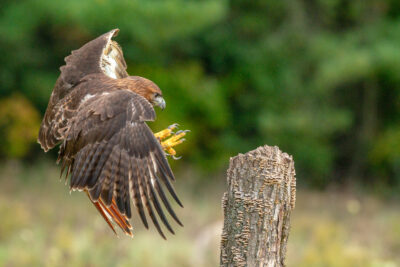
BY HARRY WEEKES

In early August I received a text: “Have you actually figured out how to ID raptors?”
My response: “No. Still a total failure. I just say ‘red-tailed hawk.’”
Then, about a week later, I got into a conversation about raptors in the Sawtooth Valley, specifically that there were, all of a sudden, a bunch of raptors out Pole Creek Road. There were some big raptors (maybe immature golden eagles?), some others with heavily barred tails and faces (maybe Peregrine falcons?), and then just “more than a normal amount of raptors” (maybe some special, late-summer, Tolkien-esque bird summit?).
This led to my usual verbal field trips—where I ask anyone who will listen about the topic in which I am interested. There are always surprises in these conversations in that, invariably, someone will light up and say, “Are you talking about those huge birds circling around?” Or, “Yeah, I saw a frog at the Indian Creek pond.” Or, “I saw a rabbit all stretched out, too.” In other words, no matter what I ask, I find someone who has caught a glimpse of what I am talking about. Mostly these are adults, and the exchange is always filled with a kind of wonder and sense of the conspiratorial—“We are in this together.”
When I get enough hits on these verbal field trips, a physical one usual emerges. “Well, if everyone is telling me there are ‘like, 40,000 Sandhill cranes’ in the Triangle, I am heading to the Triangle. If there is a little group of bucks in velvet that seem to sneak out of a hidden canyon in Indian Creek and wade into the alfalfa, but only at a certain light, I am going to make sure to drive home at that time.
So, texts were sent, times were discussed, and one Sunday morning I was riding shotgun, creeping along a jeep trail with binoculars, a spotting scope, two field guides, and a “Hawks in Flight” book.
Birds are known by many collective nouns. A group of golden eagles is called a convocation. A group of Peregrine falcons is called a bazaar. A group of red-tailed hawks could be called a frustration. Or a confusion. Or a “These can’t all be red-taileds, can they?”
The first thing you notice about red-tailed hawks when you are flipping through “Sibley Birds West” is that they occupy two pages, not one. This is because there are light morphs, dark morphs, Krider’s, Harlan’s, partial albinos, and about every possible color combination of brown, reddish and white. Throw in the fact that the adults and juveniles look different and here is the picture that developed. The Peregrine falcon? An immature red-tailed with a heavily barred tail, spending most of its time in the burned trees. The immature golden eagles? Mature adult red-taileds, with poorly filled-in wings, making them look like immature birds.
As with so many things, I ended at the beginning. “Have you actually figured out how to ID raptors?” Nope. But I can tell you where there are a bunch of red-tailed hawks. And if you want to go there, it is worth every minute.
Harry Weekes is the founder and head of school at The Sage School in Hailey. This is his 48th year in the Wood River Valley, where he lives with Hilary and two of their three baby adults—Penelope and Simon. The other member of the flock, Georgia, is currently fledging at Davidson College in North Carolina.


